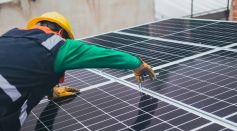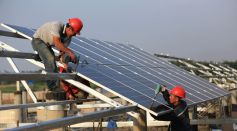Tags: Solar cells

Scientists Created Colorful Solar Panels to Make Them More Captivating to Onlookers

What is Solar Paint and Can it Revolutionize Green Architecture?

How Does Light-Induced Degradation Reduce Efficiency of Silicon Solar Cells? Scientists Explore This Problem

Biochemistry Researchers Identified How Organic Solar Cells Could Be More Efficient

Transparent Solar Cells Could Be Possible Soon With Novel Electrode as the Building Block
Fraunhofer Institutes Looking to Mass Produce Textile-Based Solar Cells
Mystery of Defects on Solar Cells Now Solved
Making solar cells is like buttering bread
New Antibiotic Discovered Against Drug-Resistant Pathogens In Microbes From Italian Soil
More Efficient Solar Cells Discovery Enhances Solar Energy Conversion Rate Up To 700%
Perovskite Holds The Future Of Solar Cells Technology As Scientists Discover Its 'Ferroelasticity' Property
Solar Cell Can Be More Efficient Using New Self-Organize Material
This New Transparent Film May Revolutionize Productivity Of Electronics & Solar Cells
Diamond-Like Thick Crystals Can Reflect All Colors Of Light In Multiple Directions
Solvent Baths Promise Better Perovskite Crystals and Better Solar Energy
How One Innovation May Change the Solar Energy Game Forever
Most Popular

El Niño and La Niña Explained: How Climate Cycles Drive Extreme Global Weather Patterns

NASA Aurora Research Reveals How ESA Space Weather Teams Use Satellite Aurora Imaging and Ground Sensors

Can EV Batteries Be Recycled? How Lithium Recovery Supports Sustainable Batteries

Coral Bleaching Crisis: How Ocean Warming Threatens Marine Ecosystems Worldwide




